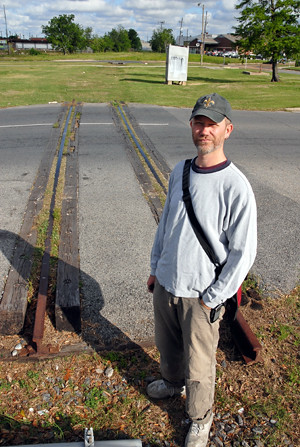From New Orleans City Business:
City moving closer to work on creating Lafitte greenway
Redeveloping 3-mile stretch from Quarter to Lakeview billed as recreation hot spot
by Emilie Bahr, Staff WriterThe city has chosen a contractor to plan and design a long-anticipated greenway for a mostly derelict stretch of land connecting Mid-City, Tremé, the French Quarter and Lakeview.
Proponents say transforming the Lafitte Corridor, a ribbon of land that passes through some of the city’s most historic and storm-damaged neighborhoods, into an alternative transportation corridor would offer residents a valuable new amenity while reinvigorating surrounding communities.
In 2006, Bart Everson helped start Friends of Lafitte Corridor, one of the groups advocating for a linear park that has at its center a paved bicycle and pedestrian path.
(Photo by Frank Aymami)“It’s not just a bike and pedestrian path,” Everson said. “It’s also an economic revitalization plan for the surrounding neighborhoods.”
The corridor runs along a former shipping channel that once connected the northern edge of the French Quarter with Bayou St. John. The canal was filled in 1938, and part of the site was converted to a rail line.
Plans to convert the largely abandoned, three-mile industrial strip into a public greenway have been floated since the 1970s, but the proposals never gained much mainstream traction until Hurricane Katrina.
Jake Wagner, an urban planning specialist helping shape greenway plans, said the storm provided the impetus for translating what for years seemed little more than an idealist’s fantasy into a real possibility. Since the storm, a revitalized Lafitte Corridor has been incorporated in all of the city redevelopment proposals.
The city has chosen Design Workshop of Austin, Texas, to do the planning and design work on the project, which is slated to be built in phases. The trail portion of the greenway will be completed in the first phase, said Debravka Gilic, director of strategic planning for the Office of Recovery and Development Administration.
According to FOLC, about $3 million has been set aside for planning, design and construction, including about $2.6 million in community development block grants.
Everson said the eventual cost of the greenway will depend on the scope of the final proposal.
“The cost is so variable depending on how you want to do it,” he said.
Completion of the trail portion of the greenway could likely be accomplished for about $3 million, but more money is needed to make the project “the true community amenity it can become,” said Billy Fields, director of the Center for Urban and Public Affairs at the University of New Orleans.
“It’s the low-hanging fruit,” said greenway advocate Geoff Coats, formerly of the Urban Conservancy, which has worked with FOLC, other organizations and area residents to get the project going.
At a time of deep public frustration over few visible signs of post-storm recovery, Coats sees the greenway project as one city officials can point to as a success story.
“I think it’s one of the most fully baked, fully developed projects,” he said. “There’s no downside to it at all that I can see.”
Planners envision locals using the greenway for recreation and bicycle commuting, while tourists would make their way from their French Quarter hotels to City Park, the New Orleans Museum of Art and Bayou St. John.
Wagner believes the greenway could be incorporated into cultural heritage tourism.
“You can explain most of the major phases of New Orleans history in that small three-mile stretch,” he said. “You’ve got the entire architectural history of the city” represented.
Fields, former research director for the Rails-to-Trails Conservancy in Washington, D.C., said the greenway could serve as a model for trail-oriented development, a concept that plays on transit-rooted development, or the idea that private investment naturally follows public investment in major transportation nodes.
“You see this in New York, in Tokyo, on a massive scale,” Wagner said, referring to the concentrations of commercial development that can be found in those cities around large subway stops.
Charlie Doerr, owner of the Bayou St. John store Bayou Bicycles, is among the business owners hoping to reap the greenway’s benefits.
“Our backdoor opens out basically right on to it,” said Doerr, sitting in his office looking through a window at what is currently vacant land. But he is optimistic that one day, he’ll be watching bicyclists, walkers and runners move by. He’s already started thinking about starting a bike rental service to tap into the influx of new visitors.
“Once the thing is open, people are gonna use it and we’ll be right in the middle of it,” he said.
Nice article. Now if you want to learn more, please come to the upcoming meeting of Friends of Lafitte Corridor:
Design Professionals Explain the Work about to be Done on the Greenway and hear about FOLC’s 5th Annual Corridor Hike
Come join us for the latest Greenway update and news of our upcoming Corridor Hike! The City is about to award a contract for Lafitte Greenway design and Lafitte Corridor Revitalization planning. Learn exactly what that entails and how you can have your say in what the Greenway will be like. Lake Douglas, FOLC Board member and LSU Professor of Landscape Architecture; and Daniel Samuels, architect and past President of FOLC; and current Chair of the Lafitte Greenway Steering Advisory Committee, explain the process and tell you what sort of timeline we anticipate for construction. Also Bart Everson and Jeff Schwartz will announce plans for our 5th Annual Hike of the Lafitte Corridor. – It’s all at the FOLC Membership Meeting – Thurs April 23rd at 6:30PM at Grace Episcopal Church, 3700 Canal St.
Bring a friend & sign up for FOLC membership
Discover more from b.rox
Subscribe to get the latest posts sent to your email.

Congratulations on your progress. It’s truly commendable.
It’s amazing how much money and effort is involved in getting a project like this, a seeming no-brainer, this close to being accomplished.